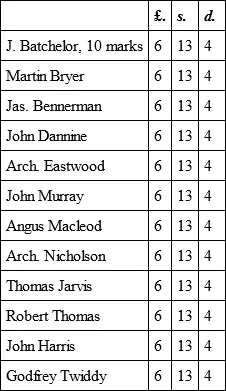Richard Cannon - Historical Record of the First Regiment of Foot
Здесь есть возможность читать онлайн «Richard Cannon - Historical Record of the First Regiment of Foot» — ознакомительный отрывок электронной книги совершенно бесплатно, а после прочтения отрывка купить полную версию. В некоторых случаях можно слушать аудио, скачать через торрент в формате fb2 и присутствует краткое содержание. Жанр: foreign_antique, foreign_prose, на английском языке. Описание произведения, (предисловие) а так же отзывы посетителей доступны на портале библиотеки ЛибКат.
- Название:Historical Record of the First Regiment of Foot
- Автор:
- Жанр:
- Год:неизвестен
- ISBN:нет данных
- Рейтинг книги:4 / 5. Голосов: 1
-
Избранное:Добавить в избранное
- Отзывы:
-
Ваша оценка:
- 80
- 1
- 2
- 3
- 4
- 5
Historical Record of the First Regiment of Foot: краткое содержание, описание и аннотация
Предлагаем к чтению аннотацию, описание, краткое содержание или предисловие (зависит от того, что написал сам автор книги «Historical Record of the First Regiment of Foot»). Если вы не нашли необходимую информацию о книге — напишите в комментариях, мы постараемся отыскать её.
Historical Record of the First Regiment of Foot — читать онлайн ознакомительный отрывок
Ниже представлен текст книги, разбитый по страницам. Система сохранения места последней прочитанной страницы, позволяет с удобством читать онлайн бесплатно книгу «Historical Record of the First Regiment of Foot», без необходимости каждый раз заново искать на чём Вы остановились. Поставьте закладку, и сможете в любой момент перейти на страницу, на которой закончили чтение.
Интервал:
Закладка:
"James R.
"Whereas by the establishment of our forces, we have been graciously pleased to direct that an allowance be made to such officers and soldiers as should be wounded or hurt in our service; our will and pleasure is, that out of such monies as are or shall come to your hands for the contingent use of our guards, &c., you cause the sums following to be paid to the officers, non-commissioned officers, and soldiers, of our Royal Regiment of Foot, hereunder mentioned, viz.: —

"Which sums, amounting to three hundred and ninety-seven pounds, are to be paid to the said persons, in satisfaction for their wounds received in our service during the late rebellion; provided none of them be already admitted to the allowance appointed for our Royal Hospital, near Chelsea. And for so doing, this, together with the acquittances of the said persons, or their assigns, shall be your discharge.
"Given at our Court at Whitehall this 16th day of May, 1686.
"By his Majesty's command,
"William Blathwayte."To our trusty and well-beloved Cousin and Councillor Richard, Earl of Ranelagh, our Paymaster-General, &c. &c. &c."
The following men of the Royal Regiment, who were admitted into the Royal Hospital at Chelsea, received the sums set down against their names: —

Serjeant Weems of the Royal Regiment particularly distinguished himself; and a warrant of James II. directs that he should be paid "Forty pounds for good service in the action at Sedgemoor, in firing the great guns against the rebels."
A few days after the battle, the establishment of the Royal Regiment was reduced from 100 to 50 private men per company; and in August eleven companies were encamped on Hounslow Heath, where they were reviewed by the King. In September, thirteen companies marched to Winchester, to attend the court at that city; and the regiment passed the winter at Portsmouth and Exeter, with one company detached to Lynn.
At this period the establishment of the regiment consisted of 1 colonel, 1 lieutenant-colonel, 1 major, 18 captains, 1 captain-lieutenant, 41 lieutenants, 21 ensigns, 1 adjutant, 1 chaplain, 1 quarter-master and marshal, 1 chirurgeon, 1 chirurgeon's mate, 1 drum-major, 1 piper, 42 drummers, 63 serjeants, 63 corporals, and 1050 private soldiers. The privilege of having two lieutenants and three serjeants to each company appears to have been peculiar to this regiment; and a warrant of King James II., dated the 1st of January, 1686, directs that "As any of the lieutenants of the Royal Regiment shall die, or be displaced, their number be reduced to one lieutenant only in each company of this regiment; and that as the serjeants shall die, or be displaced, they be in the same manner reduced to two in each company." 68 68 War-Office Establishment Book.
On the 1st of March, 1686, a second adjutant and a second surgeon's mate were added to the establishment, and the regiment was again divided into two battalions; the first battalion consisting of eleven, and the second of ten companies; and in April the second battalion embarked at Gravesend for Scotland. At the same time the whole of the first battalion was placed in garrison at Portsmouth, from whence it marched in June following to the vicinity of Hounslow, and on the 24th of that month erected its tents on the heath, where about twelve thousand men were encamped, under the orders of Lieut. – Generals the Earls of Feversham and Dumbarton, and were frequently exercised in presence of the royal family. In July, four companies marched from Hounslow Heath, and encamped near Tunbridge Wells, to attend the Princess Anne (afterwards Queen Anne) during her residence at that place; and in August the battalion struck its tents, and marched to Yarmouth and Bungay, with a detachment at Landguard-Fort, where it passed the winter.
From these quarters the first battalion was removed in the spring of 1637 to the vicinity of London, where it halted a few days, and afterwards proceeded to Portsmouth, and passed the summer months in that garrison. In the autumn it marched into Yorkshire; and the men were employed dining the winter in working on the fortifications at Hull.
In April, 1688, the first battalion was recalled from Yorkshire, and was stationed at Greenwich, Woolwich, and Deptford, until the 26th of June, when it encamped on Hounslow Heath.
In the meantime the second battalion had marched from Scotland to York. In August it proceeded to Hertford and Ware; and in September to Gravesend, where the first battalion had previously arrived from Hounslow Heath; and the two battalions being again united, occupied Gravesend, Tilbury-Fort, Sheerness, and other places along the banks of the Thames and the coast of Kent.
At this period the nation was violently agitated by political events. The King, being a roman catholic, and being guided by jesuitical councils, and countenanced and encouraged by a few families of the same persuasion, was attempting to effect the subversion of the established religion and laws. At the same time many noblemen and gentlemen who felt the greatest concern for the welfare of their country had invited the Prince of Orange to come to England with a Dutch army to aid them in resisting the proceedings of the court. Thus the kingdom was divided against itself, and men were looking forward, with a mixed feeling of hope, terror, and consternation, to the great convulsion which threatened the State. The King made preparations to avert the danger, and augmented his army, when the Royal Regiment was increased to 26 companies, and the total strength to 1858 officers and soldiers, each battalion having now a grenadier company.
In the early part of November, the Dutch fleet having sailed past Dover, the Royal Regiment was ordered to the west; and when the Prince of Orange had landed at Torbay and advanced to Exeter, it proceeded to Warminster, which was the most advanced post of the royal army. The head-quarters were at Salisbury, and King James reviewed his army on Salisbury Plain on the 21st of November. But his Majesty found that his conduct had alienated the affections not only of his subjects in general, but of the officers and soldiers of his army, many of whom forsook his camp and joined the Prince of Orange. Yet, while many of the nobility and gentry, with officers and soldiers from almost every regiment in the army, were quitting the King's standard daily, the Royal Regiment of Foot was an exception; it preserved its ranks entire, and stood with an unshaken loyalty amidst the general defection which prevailed in the kingdom.
Конец ознакомительного фрагмента.
Текст предоставлен ООО «ЛитРес».
Прочитайте эту книгу целиком, купив полную легальную версию на ЛитРес.
Безопасно оплатить книгу можно банковской картой Visa, MasterCard, Maestro, со счета мобильного телефона, с платежного терминала, в салоне МТС или Связной, через PayPal, WebMoney, Яндекс.Деньги, QIWI Кошелек, бонусными картами или другим удобным Вам способом.
Читать дальшеИнтервал:
Закладка:
Похожие книги на «Historical Record of the First Regiment of Foot»
Представляем Вашему вниманию похожие книги на «Historical Record of the First Regiment of Foot» списком для выбора. Мы отобрали схожую по названию и смыслу литературу в надежде предоставить читателям больше вариантов отыскать новые, интересные, ещё непрочитанные произведения.
Обсуждение, отзывы о книге «Historical Record of the First Regiment of Foot» и просто собственные мнения читателей. Оставьте ваши комментарии, напишите, что Вы думаете о произведении, его смысле или главных героях. Укажите что конкретно понравилось, а что нет, и почему Вы так считаете.












